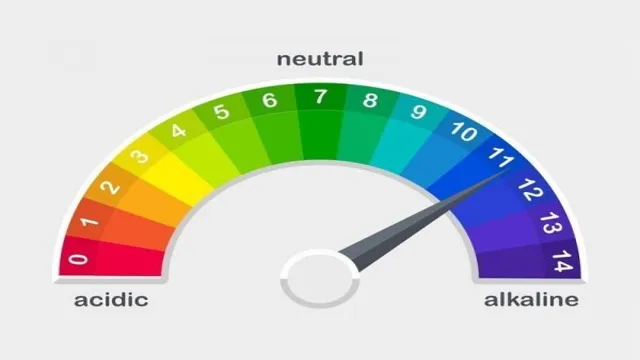Maintaining the perfect pH level in your freshwater aquarium is crucial for the health and well-being of your fish and plants. It can be a tricky balance to achieve, but with a little knowledge and regular monitoring, you can keep your aquarium’s pH levels in check. In this blog post, we’ll explore everything you need to know about pH levels in your aquarium, why they matter, and how to take control of them.
Whether you’re a new aquarium owner or a seasoned pro, understanding pH levels is essential for keeping your aquatic inhabitants thriving. So, let’s dive in!
Understanding pH levels in Freshwater Aquariums
Maintaining the pH level in your freshwater aquarium is crucial for the health and well-being of your fish and plants. The ideal pH level for most aquariums is between 5 and
5, although some fish and plants may require different levels. To maintain the correct pH level, it’s essential to regularly test the water and adjust accordingly. There are several ways to adjust the pH level, including adding products designed to raise or lower the pH.
It’s best to make small adjustments slowly over time, rather than trying to quickly and drastically change the pH level, as this can be harmful to your aquatic inhabitants. Additionally, it’s important to consider the source of your water and any decorations or substrates that may affect the pH level. By regularly monitoring and adjusting the pH level, you can ensure that your freshwater aquarium remains a healthy and thriving environment for all of its inhabitants.
What is pH?
pH levels, freshwater aquariums pH is a measurement of the acidic or basic level of a solution. It is a crucial factor to consider when maintaining a freshwater aquarium. In simple terms, the pH scale ranges from 0 to 14, with 7 being neutral, below 7 considered acidic, and above 7 as basic or alkaline.
In a freshwater aquarium, the ideal pH level for most fish and plants is around 0 to
Any drastic fluctuations in pH levels can negatively impact the health of the aquatic inhabitants. Low pH levels can cause stress and even death to the fish, while high pH levels can lead to ammonia toxicity and bacterial infections. Maintaining the pH level within the recommended range is essential for ensuring the overall health and longevity of your aquarium inhabitants.
Measuring the pH levels is relatively easy, and various testing kits are available that provide accurate readings. Regular monitoring of the pH levels and making necessary adjustments can help maintain a stable and healthy environment for your aquarium.

Ideal pH range for Freshwater Aquariums
As a responsible aquarium owner, understanding the ideal pH range for your freshwater tank is crucial. pH is a measure of the acidity or alkalinity of the water and is measured on a scale of 0 to 14, where 7 is considered neutral. When it comes to freshwater aquariums, the ideal pH range is usually between
5 and pH levels outside of this range can stress your fish, leading to health problems, and even death.
It’s essential to maintain a stable pH in your aquarium, which means testing your water regularly and adjusting it when necessary. Certain factors can affect the pH level in your aquarium, such as the types of fish and plants in the tank, the type of substrate used, and the way you filter the water. If you’re unsure about how to maintain the ideal pH range in your freshwater aquarium, don’t hesitate to seek advice from aquatic experts.
By keeping your pH levels within the ideal range, you’ll help ensure that your fish thrive and that your aquarium remains healthy and beautiful.
Factors affecting pH levels
When it comes to maintaining a healthy freshwater aquarium, understanding pH levels is crucial. pH measures the acidity or alkalinity of the water, with a neutral level being 0.
In an aquarium, pH levels can be affected by various factors, such as the type of substrate used, the amount of oxygen and carbon dioxide in the water, and the presence of fish or plants. For instance, live plants can release oxygen into the water, which can cause the pH to rise. Conversely, fish waste and decomposing organic matter can release carbon dioxide, which can lower pH levels.
It is crucial to monitor the pH levels regularly and make adjustments if needed to ensure a stable and healthy environment for your aquatic pets. By testing the water periodically and taking the necessary steps to maintain the desired pH level, you can help your fish and plants thrive in their habitat. (See Also: How to Prepare Driftwood for an Aquarium: A Step-by-Step Guide to Ensure the Best Aquatic Environment.)
Testing pH levels in your Aquarium
Testing pH levels in your freshwater aquarium is crucial to maintaining a healthy environment for your fish and aquatic plants. The pH level measures the strength of acidity or alkalinity in your aquarium’s water and can drastically affect the well-being of your pets. Ideally, a pH level between
5 and 5 is recommended for most freshwater fish species. A pH level lower than
0 can be harmful, causing stress and even death in some fish. On the other hand, a pH level higher than 0 can also be detrimental, leading to ammonia poisoning and other health issues.
Testing pH levels is a simple process using liquid test kits or digital meters specially designed for aquariums. By understanding and regulating the pH levels in your fish tank, you can prevent potentially life-threatening conditions and give your pets a healthy and thriving home.
Maintaining pH levels in Freshwater Aquariums
Maintaining pH levels in freshwater aquariums is crucial for the overall health and well-being of your aquatic pets. pH measures the acidity or alkalinity of the water and getting it wrong can lead to a range of problems, ranging from stress on your fish to a proliferation of algae. The easiest way to maintain pH levels is by testing the water regularly, which can be done using a pH kit.
A steady pH level between 5 and 5 is ideal for most freshwater fish.
A great tip for keeping pH levels stable is to perform regular water changes and avoid overfeeding your fish. Another key factor in maintaining pH levels is avoiding sudden changes in water temperature or adding too many chemicals at once, which can throw off the balance in your aquarium. In short, with some regular maintenance and attention to detail, you can easily keep the pH levels in your freshwater aquarium stable and your fish happy and healthy.
Regular Water Changes
Maintaining the pH levels in your freshwater aquarium is crucial for the health and vitality of your fish. One of the best ways to do this is by performing regular water changes. When you change the water in your aquarium, you are removing any excess waste, debris, and other contaminants that could negatively impact the pH levels in your tank.
Additionally, by replacing old water with fresh, clean, and properly treated water, you are helping to stabilize the chemical balance of your tank. This is important because sudden fluctuations in pH levels can be stressful and harmful to your fish. Generally, it is recommended to perform a 25-30% water change every two weeks to keep your aquarium in optimal condition.
However, some tanks may require more frequent or larger water changes, depending on the size of the tank and the number and type of fish. By making regular water changes a part of your aquarium maintenance routine, you can help to keep your pH levels stable and create a healthy environment for your aquatic pets.
Choose the Right Substrate
Maintaining pH levels in freshwater aquariums is crucial for the health and wellbeing of aquatic life. One way to do this is by selecting the right substrate. The substrate is the material that lines the bottom of the tank and plays a significant role in regulating pH levels.
There are several options to choose from, including sand, gravel, and soil. Sand has a neutral pH and is easy to clean, while gravel can increase the hardness of the water, making it alkaline. Soil, on the other hand, can make the water more acidic, which is ideal for plants that require a lower pH level.
It is important to keep in mind that some substrates may also release minerals and nutrients into the water, which can further affect the pH balance. Therefore, it is essential to research each option and choose the one that best suits the needs of the aquarium’s inhabitants. By selecting the right substrate, aquarium owners can maintain a healthy and stable environment for their aquatic pets.
Use pH Buffers and conditioners
Maintaining pH levels in freshwater aquariums can be a tricky task, but with the help of pH buffers and conditioners, it becomes much easier. These products are specifically designed to help keep your pH levels stable, which is essential for the health and wellbeing of your aquatic pets. pH buffers work by adding a substance that helps maintain a neutral pH balance in the water.
This is important because fish and plants require specific pH levels to thrive. pH conditioners work similarly, but they also help eliminate harmful toxins that can harm your aquatic pets. If you’re looking to maintain a healthy freshwater aquarium, it’s important to invest in high-quality pH buffers and conditioners. (See Also: How to Kill Leeches in Aquarium: Quick and Easy Methods)
These will ensure that your pH levels remain stable and your fish and plants stay healthy and happy. With the right products and a little bit of effort, you can create a thriving aquatic ecosystem in your home.
Avoid Overfeeding and Overstocking
Maintaining pH levels in freshwater aquariums is crucial for the overall health and well-being of your aquatic pets. One important factor to consider is avoiding overfeeding and overstocking, which can lead to a buildup of waste and increase the pH level in the tank. This can be harmful to your fish and other aquatic creatures.
To maintain a healthy pH level in your aquarium, it’s important to monitor the amount of food you give your fish and ensure that you don’t overstock your tank. Additionally, performing regular water changes and adding aquarium-safe materials such as driftwood or limestone can help regulate the pH level. It’s important to note that different fish species have different pH requirements, so it’s crucial to research and understand the specific needs of your aquatic pets.
With proper care and attention, you can maintain a healthy and balanced pH level in your freshwater aquarium, ensuring the health and longevity of your aquatic pets.
Monitor pH levels regularly
Maintaining pH levels in freshwater aquariums is crucial for the health and well-being of your aquatic pets. Regularly monitoring pH levels can help prevent the water from becoming too acidic or alkaline, which can harm fish and other aquatic organisms. pH levels can be influenced by a variety of factors, including the type of substrate, filtration system, and the addition of chemicals or medications.
It is important to maintain a consistent pH level that is appropriate for your specific fish species. The optimal pH range for most freshwater aquariums is between 0 and
0. A pH level outside of this range can cause stress and potentially even death in fish. Therefore, it’s vital to use a reliable pH testing kit to ensure that the pH level of your aquarium stays within the correct range.
With regular monitoring and adjustments, you can keep your fish healthy and happy. So don’t forget to keep an eye on your aquarium’s pH levels!
Troubleshooting pH Issues
One of the most critical factors in maintaining a healthy freshwater aquarium is keeping the pH levels stable. pH measures the relative acidity or alkalinity of the tank’s water and can affect the growth and overall health of aquatic plants and animals. A pH of
0 is considered neutral, values below 0 become increasingly acidic, and above 0 increasingly alkaline.
One way to ensure pH stability is to regularly test the water and adjust it if necessary. To increase pH, add baking soda, crushed coral, or limestone. To decrease pH, try using peat moss, driftwood, or carbon dioxide.
It is essential to avoid sudden and dramatic fluctuations in pH, so it’s best to make gradual changes and monitor the water carefully. By maintaining a stable pH, you can help prevent fish stress, disease, and death.
Common pH problems
When it comes to pH problems, troubleshooting is essential to ensure your system is working efficiently. Common issues such as inaccurate readings or fluctuations in pH can be frustrating, but there are solutions available. If you’re experiencing inconsistent pH levels, it may be due to a faulty electrode or calibration issues.
Ensure you’re calibrating your equipment regularly, following the manufacturer’s instructions precisely. Additionally, if you’re struggling with a low or high pH, it could be a result of poor water quality. Investing in a quality water treatment solution can help address these issues, and optimizing your nutrient solution can help maintain the desired pH range. (See Also: How to Maintain Humidity in Aquarium with Mesh Top: Tips and Tricks)
Remember, pH problems are not uncommon, but with troubleshooting steps in place, you can address them quickly and effectively.
Solutions for pH imbalances
pH imbalances When it comes to pH imbalances, there are several solutions that can help you get things back on track. One of the first things you can do is test your pH levels regularly to determine the extent of the issue. Once you know where things stand, you can start to take steps to address the problem.
For example, if your pH levels are too high, you can add acidic substances like vinegar or citrus juices to your diet to help bring things back into balance. On the other hand, if your pH levels are too low, you might need to add alkaline substances like baking soda or green vegetables to your diet. Additionally, you can supplement with minerals like magnesium and calcium that can help regulate pH levels.
By making these simple adjustments, you can troubleshoot pH issues and keep yourself feeling healthy and energized.
Conclusion
In a freshwater aquarium, maintaining a healthy pH level is key to the well-being of your aquatic friends. Regular water changes, monitoring of pH levels, and using buffering agents such as rocks or substrates can help keep pH levels stable. Remember, a happy fish is a fish living in its ideal pH range, so keep those levels steady, and your aquatic companions will thank you with their vibrant colors and playful personalities!”
FAQs
What is the ideal pH level for a freshwater aquarium?
The ideal pH level for a freshwater aquarium is between 6.8 and 7.5.
How often should I check the pH level in my freshwater aquarium?
You should check the pH level in your freshwater aquarium at least once a week.
What are some natural ways to maintain pH levels in my freshwater aquarium?
Natural ways to maintain pH levels in a freshwater aquarium include using Indian Almond Leaves or adding driftwood.
What can cause fluctuations in pH levels in my freshwater aquarium?
Fluctuations in pH levels in a freshwater aquarium can be caused by overfeeding, overstocking, or inadequate filtration.
How can I reduce high pH levels in my freshwater aquarium?
You can reduce high pH levels in your freshwater aquarium by adding aquarium-safe acids or using reverse osmosis water.
Can low pH levels harm my freshwater fish?
Yes, low pH levels can harm freshwater fish and lead to health issues or even death.
Is it possible to maintain stable pH levels in a freshwater aquarium?
Yes, it is possible to maintain stable pH levels in a freshwater aquarium by consistently monitoring the water quality and making adjustments as necessary.







